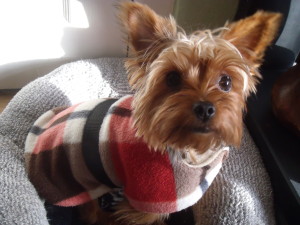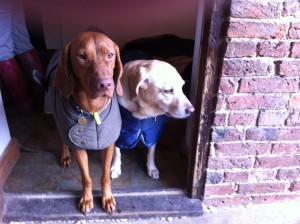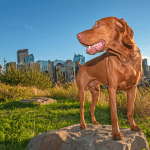Should Dogs Wear Clothes? – Benefits and Myths of Canine Clothing
The culture of canine clothing might at first seem to be a contemporary phenomenon, but the concept of ‘decorating’ dogs isn’t a new one. Read our interesting Holidays4Dogs article on canine clothing through the ages.
Quite surprisingly, as early as 1833, Princess Victoria wrote that she frequently dressed her spaniel Dash, “in a scarlet jacket and blue trousers”.
Indeed, in the 19th Century, the taste for animal fashions blossomed into a lucrative industry, much like the trends we see today.
Canine clothing in history
The French author, Paul Megnin wrote a book in the 19th Century called, ‘Nos Cheins’ and included in this were descriptions of particular outfits for certain occasions, such as evenings out and trips to the beach.
He does concede, however, that some people find the practice of dressing dogs, “grotesque” by imposing the human practice of clothing on their little pet dogs.
Another French Author writing around the same period, Jean Robert, defended the idea of putting clothes on dogs. Robert argued it was a sensible custom, particularly during the winter months. He believed that clothing delicate and sensitive dogs was a matter of common sense and good management. Roberts carried advertisements in his book from the famous Palais-Royal, offering housecoats, shirts and raincoats for the “little apartment dogs”.
Clothing as a status symbol
The sort of canine clothing a dog wears can be a representation of the owner’s identity and this is not a new concept.
can be a representation of the owner’s identity and this is not a new concept.
Historically, this was important amongst the Bourgeoisie for expressing their status. At the same time, it removed ‘beastly’ characteristics from pets living within the home environment.
Even as far back as ancient Egypt, dogs wore intricate and beautiful adornments in the form of leather and metal collars – often encrusted with precious metals and stones.
Dog clothing is not a new occurrence. Therefore, perhaps, this provides a sense of acceptance for the reasons why some people choose to dress their dogs up in modern times.
Generally, the sub-culture of dressing dogs applies to the minority of the dog-owning public. Additionally, like human fashion, canine fashion is subjective – but the question might be, does this mean it’s harmful?
Is canine clothing harmful?
In 2009, the RSPCA campaigned quite vigorously against dog clothing – comparing dressing a dog in clothes during warm weather, to leaving a dog in a hot car. They argued that owners who consistently engage in this practice should face prosecution.
However, as we have discovered, dressing dogs up in clothing is not a new idea. If practised responsibly, canine clothing need not necessarily be cruel and this is the reason why the RSPCA eventually dropped this campaign. 
There are critics of people who dress up their dogs since they argue this implies cruelty and is demeaning. However, feeling humiliated, or embarrassed, are not emotions that experts believe dogs can have.
Clothing to maintain health
It should be noted that clothing can confuse communication signals between dogs. Clothing can inhibit the ability of other dogs to read signals and body language.
Canine clothing can be regarded as a basis for maintaining health or preventing injury. Greyhounds, whippets, toy breeds and elderly dogs can benefit from extra protection from the colder elements during winter months.
A coat can help to keep mud and wet from soaking long-coated breeds. It makes grooming easier and less painful for the dog. It is also means less dirt being brought into the house as well as, reduced drying time.
Elderly dogs, especially those with kidney conditions, or arthritis, will also benefit from extra protection from the cold and wet.
Conclusion
When all is said and done, non-essential items of canine clothing should never be forced upon the dog. Anything a dog wears must fit correctly. Dogs should not be forced to wear clothing for long periods. Likewise, any item of clothing the dog wears must never inhibit his, or her, movement.
If you’re interested in making clothes for yourself with dog hair – yes, it is a thing! – head over to our other Holidays4Dogs article – knitting with dog hair for more information.
Holidays4dogs.co.uk and 4Dogs are participants in the Amazon Services LLC Associates Program, an affiliate advertising program designed to provide a means for sites to earn commission fees by advertising and linking to the following websites. Read our full disclosure agreement here https://www.holidays4dogs.co.uk/affiliate-disclosure/


